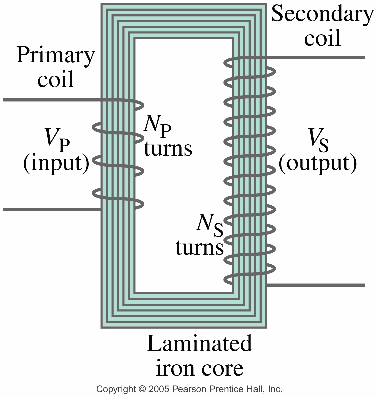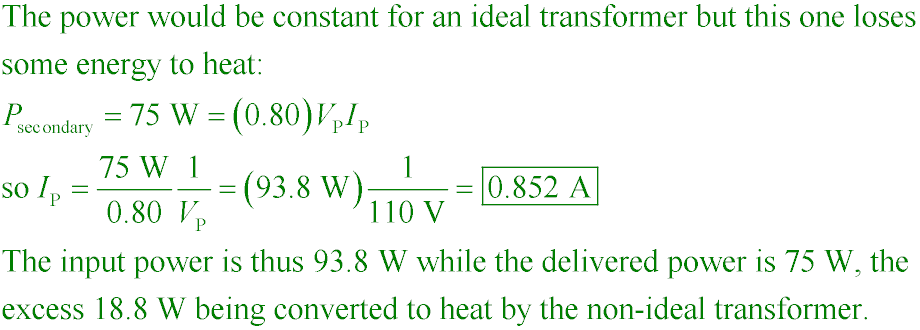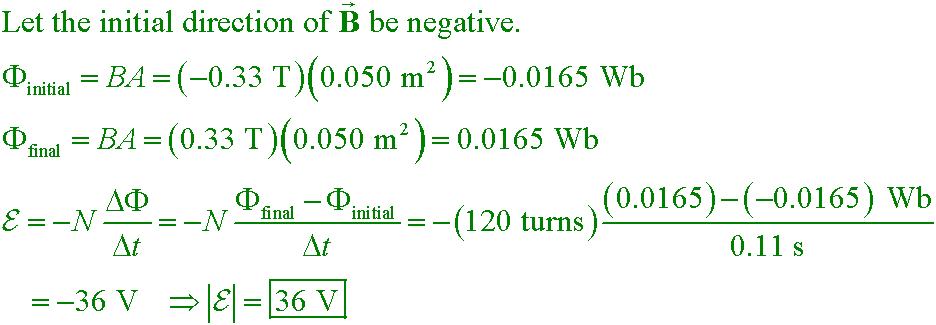Summary
- Motional emf
- Magnetic flux
- Faraday's law
- Lenz's law
- Quiz Bonus Ch.22
- More about Faraday's law

- Transformers

- Lecture learning outcomes
A student who masters the topics in this lecture will be able to:
- describe the energy transformations that occur when a current is induced in a loop by a changing magnetic flux
- use Faraday's law to explain how a transformer can change an alternating-current (AC) voltage either higher or lower
- use algebra to find the primary voltage VP, secondary voltage VS, primary number of turns NP, or secondary number of turns NS when any three of these quantities are given
- use algebra to find the primary voltage VP, secondary voltage VS, primary current IP, or secondary current IS when any three of these quantities are given
Practice:
Try these additional examples
Example #7
Example #8
Prepare:
Read textbook section 25-1 before the next lecture
Knight2 33.cq.12a
The figure shows a current-carrying wire passing between two bar magnets. Is there a force on the
wire? If so, in what direction? If not, why not?

A. Yes ... upward
B. Yes ... to the right
C. Yes ... downward
D. Yes ... to the left
E. No, because B is perpendicular to I
F. No, because B = 0 at the wire
Answer
POP4 23.13
An ℓ = 1.2 m frictionless bar is at x = 1.0 m and slides at 2.0 m/s in a 2.50-T magnetic field as shown. Use Faraday's law to find the current in the circuit if R = 6.0 Ω.
 A. 0.417 A
A. 0.417 A
B. 0.833 A
C. 1.00 A
D. 2.50 A
Answer
klm
Current is produced in a loop when a magnet is moved into the loop. Where does the electrical
energy come from?
A. Energy stored in the wire atoms.
B. Energy stored in the magnet
C. Energy in the magnet's motion.
D. Energy in electric waves.
Answer
klm
A light bulb attached to a coil lights up when it is brought near a solenoid that carries an alternating
current. Where does the electrical energy come from?
A. Energy stored in the wire atoms.
B. Energy stored in the magnet
C. Energy in the magnet's motion.
D. Energy in electric waves.
Answer
Walker5e 23.68
Find the ratio of turns on the primary coil to turns on the secondary coil
NP / NS in a
transformer that will step the 120-V household voltage down to 4.5 V.
A. NP / NS = 1 / 26.7
B. NP / NS = 1 / 5.16
C. NP / NS = 5.4 / 1
D. NP / NS = 26.7 / 1
Answer
gc6 21.76a
The primary windings of an 80% efficient transformer are connected to 110 V. The secondary windings
are connected across a light bulb that has a 2.4-Ω filament and converts 75 W of electrical power
into light and heat. What is the current in the primary coil?
A. 0.682 A
B. 0.852 A
C. 1.17 A
D. 1.47 A
Answer
gc6 21.76b
The primary windings of an 80% efficient transformer are connected to 110 V. The secondary windings
are connected across a light bulb that has a 2.4-Ω filament and converts 75 W of electrical power
into light and heat. What is the ratio NP / NS?
A. 8.2
B. 5.6
C. 3.0
D. 1.2
Answer
Walker5e 23.19
A 120-turn coil oriented with its plane perpendicular to a 0.33-T magnetic field has an area of 0.050 m².
Calculate the average induced emf in this coil if the magnetic field reverses its direction in 0.11 s.
A. 36 V
B. 18 V
C. 0.44 V
D. 0.30 V
Answer
klm
A step-up transformer has an input voltage of 100 V and an output voltage of 1000 V. If half of the
loops in the secondary coil are transferred to the primary coil, what will be the new output voltage?
A. 120 V
B. 500 V
C. 250 V
D. 83.3 V
Answer
C. Yes ... downward
The current is into the page, while the magnetic field is toward
the right (out of the north pole and into the south pole). Use the right hand rule to find that
the magnetic force per unit length
I × B points downward.
C. 1.00 A

C. Energy in the magnet's motion.
Because of Lenz's law a person must do work in order to shove a
magnet into a wire loop against the opposing field created by the induced electrical current.
If the magnet does not move, there is no changing magnetic flux, and no induced current in the coil.
In this way Faraday's law describes how kinetic energy can be converted into electrical energy.
This is the foundation of how an electrical generator works.
D. Energy in electric waves.
No mechanical energy is involved. Instead, the solenoid produces
a changing magnetic field, which induces a changing electric field that circulates around it. That
changing electric field represents a displacement current that induces a changing magnetic field, and
so on. The energy propagates in the form of a wave, with the solenoid acting as the source of the waves
and the wire loop the "antenna." The changing electric field drives sufficient alternating current in the
wire loop to light the bulb.
D. NP / NS = 26.7 / 1

B. 0.852 A

A. 8.2

A. 36 V

D. 83.3 V





 A. 0.417 A
A. 0.417 A




